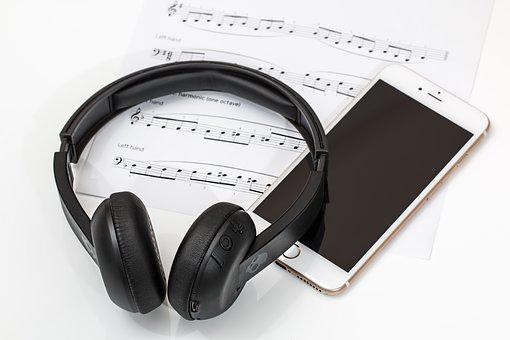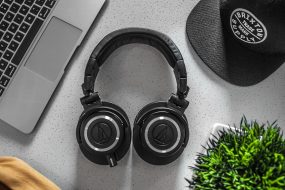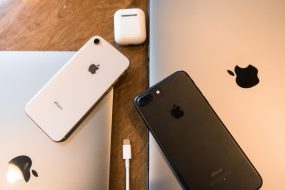
Bluetooth was inspired by a Nordic king and harnesses the power of radio. How has this wireless connectivity reshaped our electronic ecosystems.
What devices use Bluetooth? If you look around the room right now, chances are you can spot at least half a dozen electrical devices. From mobile phones and speakers to headphones and health monitors, many of these will use Bluetooth.
Without Bluetooth, each device would have to be joined together by wires, meaning you could never sit more than a few feet away from the screen.
A world of electronics connected by wires wouldn’t just be untidy, but a potential health and safety nightmare too.
Bluetooth is a method of short-range wireless communication between electronic devices that harnesses the power of radio waves.
First developed in the late 90s, the tech has become an increasingly popular way of solving the problem of more and more electrical devices needing to be connected, without having to link everything together with wires, according to the journal Nature Electronics.
Now, if you look at the remote control you use to switch channel on the TV you might rightly ask yourself why Bluetooth was such a big deal? After all, connecting devices with invisible signals had been done before.
RADIO VS INFRARED
The problem with remote controls which use infrared signals, is that they need to maintain what is called ‘line of sight’, according to a paper published in the journal IOP Conference Series: Materials Science and Engineering. If something is standing between the transmitter and receiver, it won’t work. But because Bluetooth uses radio, obstacles aren’t a problem, but it has a relatively short range of around 10m.
Since its creation in the late 90s, the tech has become more and more refined and widely used, with the four billionth Bluetooth device being shipped in 2020, according to a paper in the 2020 Mediterranean Communication and Computer Networking Conference journal.
The secret to Bluetooth is good old fashioned radio, but not quite as we know it. The main function of radio when used for broadcasting, or when we use it to broadcast mobile phone signals – is distance.
After all, a radio station wants its programmes to be heard far and wide, while mobile phone signals have to reach the nearest phone tower so it can be relayed to a receiving handset.
5G Network: How does it work, and is it dangerous?
History of computers: A brief timeline
What is electromagnetic radiation?
But Bluetooth is much less powerful than that and has a range of about 30 feet (10 meters), according to Sony’s website.
The radio spectrum stretches from 30 Hz to 300 GHz. The lower the frequency, the longer the range, but also the lower the data rate and quality it can support.
According to a paper published after the International Conference on Communications, Bluetooth operates at 2.4 GHz which gives it the right balance between range and data quality. The other benefit of this frequency is that it’s available around the world, according to Bluetooth.com, making it a standard bearer for low power, wireless connectivity.
Bluetooth traces its beginnings all the way back to the 90s. It had been conceived by Dr Jaap Haartsen at Swedish mobile giant Ericsson, according to the European Patent Office (EPO). Things really stepped up though in 1998 when the Bluetooth Special Interest Group (SIG) was formed to develop and promote the technology.
The group released Bluetooth 1.0 in 99 and a year later it began to be used in mobile phones and desktop PCs, making their way to laptops and printers in 2001, according to TechRadar. In the middle of the decade, the Bluetooth headset – which allowed people to communicate hands free – became a common sight.
ADDITIONAL RESOURCES
You can learn more about Bluetooth range from a Bluetooth consultant in this short video. Additionally, explore the latest Bluetooth headsets in TechRadar’s guide.
This page contains affiliate connections. If you click on one of the product links and then buy the item, we will receive a small commission. There is no expense to you because you will continue to pay the usual amount.
Recent Posts
- Discover Your Perfect Getaway: Exploring Home & Villas by Marriott Travel Site
- The Ultimate Guide to Booking Your Family Vacation with Home & Villas by Marriott
- Maximize Your Online Presence: Top Features of Jimdo for Entrepreneurs
- Unlocking Success: How Jimdo Empowers Your Online Business Journey
- From Ingredients to Taste: What Sets Caats Premium Cat Food Apart
Categories
- 3D Printing
- Ai Products
- Auto Mobile Company
- Automobile Company
- Beauty & skincare
- Bike & Bicycle Accessories
- Bike Parts
- Bio Technology Company
- Books
- Business & Marketing
- Car rental site
- Car Selling site
- Cats & Dogs Pet Store
- Cheese Shop
- Clothing & Fashion
- cosmetic products
- Dental Company
- Digital Marketing
- Digital Sequrity
- Domain & Hosting
- Domain Hosting
- Domain&Hosting
- Educational & Creative Site
- Educational & Creative Subscription For Children
- Electronics
- event planner
- Eyeglasses & Eyewear
- Fashion
- Fashion accessories
- Filter Bottel for travel
- Fishing kit
- Food
- Food & Grocery
- Food Delivery Site
- Footwear & Sports Shoe
- Freelance site
- Furniture & Accessories
- Games
- Growoons
- Hair Care & Skin Care
- Health
- Health & Doctors
- Health & Supplement
- Heart Health Supplements
- Home Appliances
- Home Decor Company
- Hosting and Domain
- Hotels
- House Design Company
- Innerwear Cloths
- Jewellery & Accessories
- kids toys
- Legal Service Company
- Marketing Company
- Military Equipment Store
- Mobile Company
- Online Cheese Store
- Online consulting site
- Online courses
- Online Doctor
- Online Domiciliation Company
- Online jobs
- Online Loan Company
- Online Retail Company
- Online Security
- Online Shipping Company
- Online Shopping Site
- Online Whole Sale Place
- Packaging Supplier
- Pet care & Food
- Photography
- Repairing Workshop
- Shipping Company
- Shopping site
- Social Security
- Software Company
- Sports Discovery
- Story Books & Textbook
- Study & Technology
- Supported Printer
- Tech
- Tooth Brushes Company
- Toys & All Accessories
- Transport Company
- Travel
- Travel & Airlines
- Travel Website Company
- Vpn
- Water Filter Company
- web hosting
- Website Building
Recent Post
Discover Your Perfect Getaway: Exploring Home &
- December 20, 2025
- 6 min read
The Ultimate Guide to Booking Your Family
- December 20, 2025
- 6 min read
Maximize Your Online Presence: Top Features of
- December 19, 2025
- 5 min read









